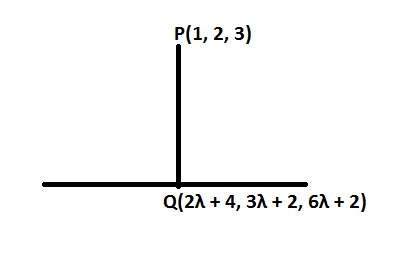Question 3:- A line passing through the point A with position vector ![]() is parallel to the vector
is parallel to the vector ![]() . Find the length of the perpendicular drawn on this line from a point P with position vector
. Find the length of the perpendicular drawn on this line from a point P with position vector ![]() [CBSE Panchkula 2015]
[CBSE Panchkula 2015]
Solution:- The equation of the line passing through the point A and parallel to ![]() is given in cartesian form as
is given in cartesian form as
![]() . . . (i)
. . . (i)

![]() (Let)
(Let)
x = 2λ + 4, y = 3λ + 2, z = 6λ + 2
Now the point Q(2λ + 4, 3λ + 2, 6λ + 2)
Position vector of point p(![]() )
)
Point P in cartesian form P(1, 2, 3)
Dr,s of the line PQ(2λ + 4 – 1, 3λ + 2 – 2, 6λ + 2 – 3)
= P(2λ + 3, 3λ, 6λ – 1)
Dr,s of the line(i) (2, 3, 6)
Since line PQ perpendicular to line(i)
2(2λ + 3) + 3(3λ) + 6(6λ – 1) = 0
⇒ 4λ + 6 + 9λ + 36λ – 6 = 0
⇒ 49λ + 0 =0
⇒ λ = 0
Hence the co-ordinate of Q(4, 2, 2)
∴ Length of perpendicular PQ = √(4 – 1)² + (2 – 2)² + (2 – 3)²
= √9 + 0 + 1 = √10 units.
Other Three Dimensional Geometry Question
Question 1:- Find the eqaaution of the line which intersect the lines ![]() and
and ![]() passes through the point (1, 1, 1)
passes through the point (1, 1, 1)
Solution:- See ful solution
Question 2:- Find the vector and cartesian equations of the line passing through the point (2 , 1, 3) and perpendicular to the lines ![]() and
and ![]() .
.
Solution:- See full solution
